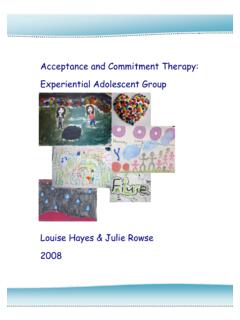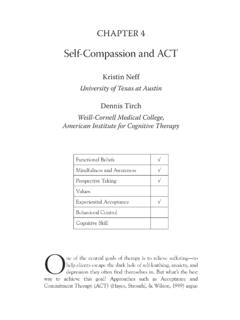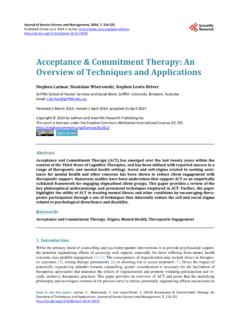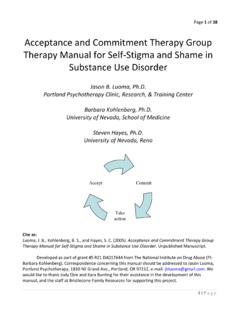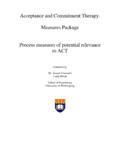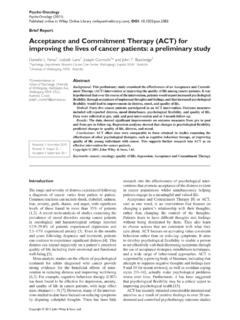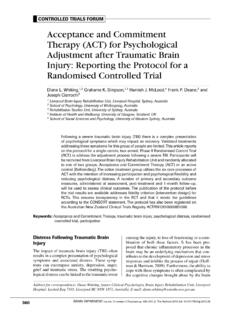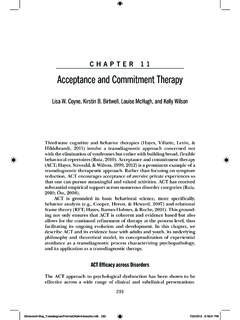Transcription of Acceptance and Commitment Therapy: …
1 1 Handouts adapted from Morton, J. (2008) Spectrum Wise Choices Acceptance and Commitment therapy : experiential adolescent group Louise Hayes & Julie Rowse 2008 2 Julie Rowse & Louise Hayes (2008) CONTENTS General group Procedures .. 4 Session 1: Where am I?.. 9 Session 2: Thoughts: Trapped or Flexible? .. 17 Session 3: Developing Willingness .. 25 Session 4: Inside my .. 31 Session 5: Mindfulness - Being Present .. 37 Session 6: This is what I value!.. 42 Session 7: On the 47 Session 8: Reflect and .. 51 WEEKLY HANDOUTS 55 References .. 66 ACT Evaluation .. 67 Permission to use artwork .. 68 3 Julie Rowse & Louise Hayes (2008) ACKNOWLEDGEMENTS Louise Hayes and Julie Rowse would like to acknowledge the willingness of the ACT community to share their knowledge and resources.
2 Many of the ideas in this program are adaptations from other ACT works and we have attempted to acknowledge the works of these authors. Without this Commitment to sharing knowledge the development of this program would not have occurred. We would also like to particularly thank Laurie Greco for her willingness to share her resources and her own work with adolescents (Greco, 2006). Artwork used in this document should not be reproduced in anyway. All participant artwork has been used with written consent from the participants. We would like to express our thanks to the teenagers who have shared their experiences with us. Thank you. Correspondence to: Dr Louise Hayes, University of Ballarat, Mount Helen, Victoria, Australia. 4 Julie Rowse & Louise Hayes (2008) GENERAL group PROCEDURES The aim of this group program is to use experiential mediums, for example painting or clay, to facilitate teenagers experience of the ACT concepts.
3 Art allows them to explore their own experiences, without getting caught up in language processes. The group program also makes use of role play and other forms of experience. Facilitators need a sound understanding of Acceptance and Commitment therapy , should be familiar with working with adolescents and have experience in group facilitation. Ideally, facilitators should have worked individually with adolescent clients before taking on this group work. It is recommended that facilitators attend ACT training and be familiar with the literature and the Association for Contextual Behavioral Science ( ). Some suggested readings include: Greco, L. A., & Hayes, S. C. (Eds.). (2008). Acceptance and mindfulness treatments for children and adolescents: a practitioner's guide. Oakland CA: New Harbinger. Hayes, S.
4 C., & Smith, S. (2005). Get out of your mind and into your life. Oakland CA: New Harbinger. Hayes, S. C., Strosahl, K. D., & Wilson, K. G. (1999). Acceptance and Commitment therapy : An experiential approach to behavior change. New York: The Guilford Press. Luoma, J. B., Hayes, S. C., & Walser, R. D. (2007). Learning ACT: an Acceptance and Commitment therapy skills training manual for therapists. Oakland CA: New Harbinger. Zettle, R. D. (2007). ACT for depression: A clinician's guide to using Acceptance and Commitment therapy in treating depression. Oakland CA: New Harbinger. 5 Julie Rowse & Louise Hayes (2008) WHO IS THIS PROGRAM FOR? In a group format, the program is suitable for adolescents aged 13 to 18 years. We have found that at the younger end, some teens find it hard to link the metaphors used in the art exercises and need a bit more support.
5 The program could be easily adapted for use individually with clients of any age. Selecting adolescents for the group requires some careful planning. Issues to consider include: 1. We have included up to 8 participants with two facilitators. 2. Should the group be single sex or mixed sexes? To date we have run this only with single sex groups as we felt that the developmental level of boys and girls would make combined groups too challenging. 3. The range of ages within one group should be no more than two years, for example 13 to 15 year olds, or 15 to 17 year olds. 4. Adolescents have informed us that sense of belonging is an important group process. We aim to create a cohesive group where each participant feels supported. Selection of participants requires some prior knowledge to the adolescents.
6 For our groups in schools, participants were experiencing anxious or depressive symptoms. We excluded from the group teenagers with recent bereavement, intellectual disability, or acute levels of mental illness (psychosis, acute suicidality). SESSION DURATION The duration of ACT sessions can be 60 to 120 minutes although this can change depending on the group location, purpose, and participants in the group . We have found shorter duration is better than too long, but we have found after a few sessions the adolescents are more open in the discussion and the sessions can take longer if time 6 Julie Rowse & Louise Hayes (2008) permits. To optimise attendance weekly sessions on a set day of the week at the same time is best, for example each Wednesday at 11am for an hour. ASSESSMENT AND INFORMED CONSENT We strongly recommend that prior to each group the facilitators meet individually with each participant for approximately 20-30 minutes.
7 There are four objectives for this meeting: 1. to assess the adolescent s current mental health, giving consideration to appropriateness for the group and referral for other services if necessary, 2. to explain why they have been asked to participate, the purpose of the group , and the type of activities, 3. to obtain informed consent and give adolescents a brief overview of ACT, 4. to collect pre-intervention measures, 5. to assess the adolescents current mental health, giving consideration to appropriateness for the group and referral for other services if necessary, In schools we have found that teenagers mostly want to know why they have been chosen. While these individual interviews are time consuming we have found without them teenagers can be quite sceptical about participation. Some areas for discussion include: What the group is about?
8 What ACT is about we use the phrase Accept, Choose and Take action and describe that ACT uses experiences, like art, to help teenagers learn about valued living and dealing with difficulty. The groups we facilitated were part of a research project and we were required to obtain written permission from the teenagers and their parents. We used an invitation flyer as well as the formal plain language statement required for ethical research. 7 Julie Rowse & Louise Hayes (2008) ASSESSMENT MATERIALS Determining the effectiveness of the group is important. Outcome or process measures will depend on your purpose for delivering this program as well as the population you are working with. We have used general measures of adolescent well-being (Reynold s adolescent Depression Scale) and also included process measures specific to ACT (Avoidance and Fusion Questionnaire, Greco).
9 At a minimum we recommend you administer a basic measure to obtain satisfaction and feedback on your group process (see Handouts section). PROCESS ISSUES The process of facilitating the ACT art groups is important to the delivery of the program. When painting or drawing we strongly and repeatedly explain to the adolescents that this group is not about being a good artist or producing a great piece of work. The artwork does not have to be a recognisable image; it can be an abstract, a colour, a shape (if absolutely stuck they can use words). Some adolescents will require support to begin or to understand how to express themselves with art. Facilitators can have pre-prepared examples of how to express some of the concepts although it is best to allow time for the adolescents to use their own creativity to ensure individual expression.
10 1. Set the group up on a shared large table so everyone can see each other and talk while they paint. 2. Facilitators must adopt the ACT I and thou stance that is central to ACT. Facilitators also need to complete their own artwork for all activities. 3. Facilitators should model the ACT concepts with their own art, taking care to ensure it is at an appropriate level for their participants. We usually model simple art (often joking about our bad art ) in the beginning so that no-one feels the standard is too high. For the first painting we will often use just colours on a page. 4. While the artwork is in progress the facilitators can encourage dialogue in keeping with ACT processes. Sometimes the teenagers drift off into casual 8 Julie Rowse & Louise Hayes (2008) conversation and this can be OK too.
